To put a blade into a Dewalt reciprocating saw, first, ensure its power source is off, then pull the blade release lever, insert the blade into the blade holder, and release the lever.
Dewalt reciprocating saws are popular for their power and efficiency in cutting materials such as metal, wood, and plastic. They are commonly used by builders, plumbers, electricians, and DIY lovers.
To change a blade on a Dewalt reciprocating saw, it is essential to follow the right procedure to avoid accidents.
In this article, we will describe how to put a blade into a Dewalt reciprocating saw safely and efficiently. We’ll also provide guidelines, tips, and precautions to help you handle this task professionally.
Whether you are a beginner or an experienced operator, this guide will help you get the job done with ease.
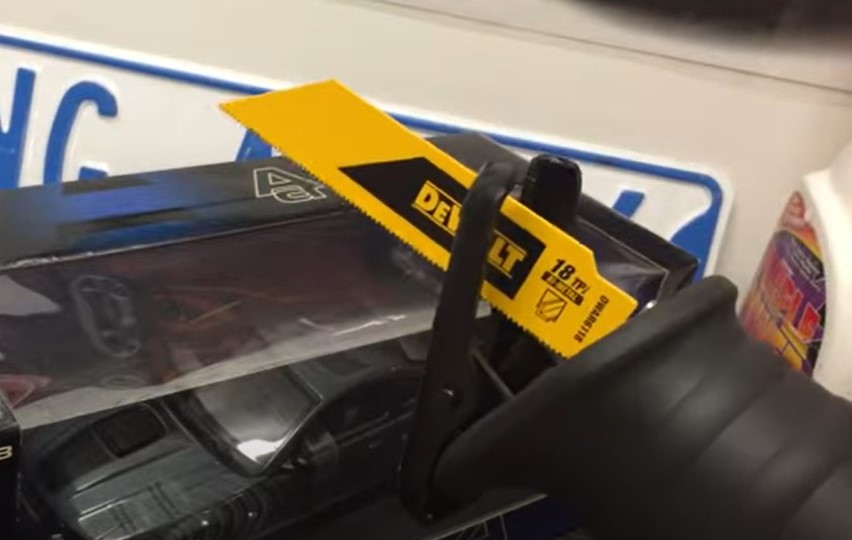
Safety First! To Put A Blade Into A Dewalt Reciprocating Saw!
Reciprocating saws are powerful tools that are capable of cutting through almost anything. As a result, safety should be the top priority when using a reciprocating saw. Before putting a blade into a Dewalt reciprocating saw, there are several safety precautions that you must take.
Here are some of the essential steps to follow:
Dressing Properly Before Changing The Blade
Before you begin any work with a reciprocating saw, you must first dress appropriately. Here are some of the things to keep in mind:
- Wear a pair of thick gloves to protect your hands from any debris or cuts.
- Use safety glasses to prevent any dust and debris from getting into your eyes.
- Put on ear protection to prevent any hearing damage.
- Wear a dust mask to avoid inhaling any dust or debris.
Removing The Battery/ Unplugging The Saw
Now that you’ve dressed for safety, it’s time to remove the battery or unplug the saw. This process is crucial to ensuring that you don’t accidentally start the saw while changing the blade.
Follow these steps:
- Confirm that the saw is unplugged from the power source or that the battery has been removed.
- You can check that the saw is unplugged by pressing the trigger.
- There should be no movement, sound, or vibration.
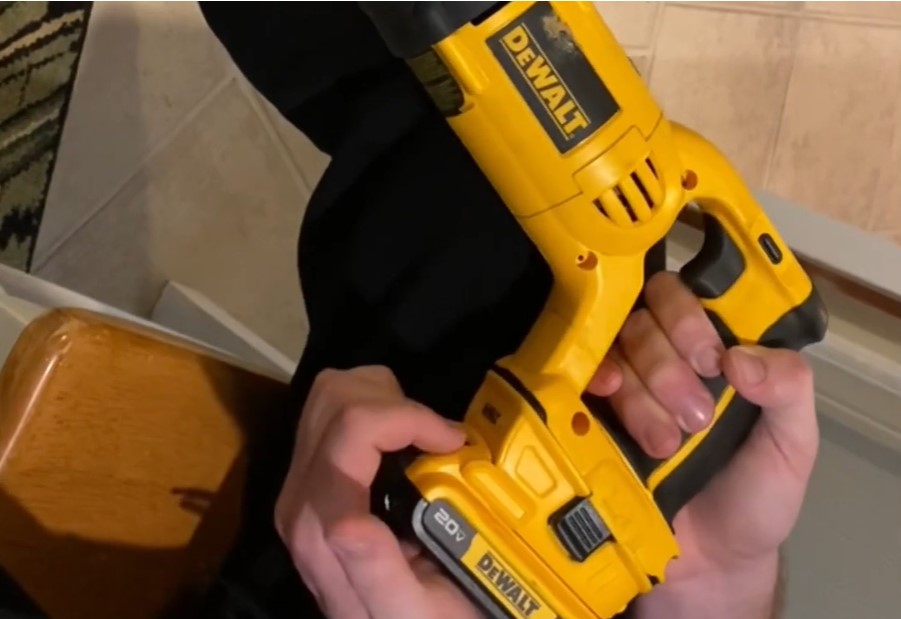
Examining The Saw For Defects
Before starting the blade-change process, it’s vital to check the condition of your saw and ensure that it’s in perfect working order. Here are some essential checks to conduct:
- Check the cord and plug – ensure that they are not frayed, cut, or damaged.
- Inspect the blade holder to make sure that it’s secure and undamaged.
- Check the blade clamp to ensure that it is free of debris, rust, or damage.
Preparing The Saw For Blade Removal
Once you’ve checked the saw for defects, it’s now time to prepare the saw for blade removal.
Here’s what you need to do:
- Pull the blade holder out of the saw while pressing the blade release button.
- Place it on the side and ensure that the teeth are not facing you.
- Clean the blade clamp and make sure it’s free of any rust or debris.
- Use a blade wrench to loosen the blade.
Blade changing can be a dangerous process if not handled carefully. By following these essential safety precautions, you can ensure that you stay safe when handling a reciprocating saw.
Remember, safety should always be your top priority when using a power tool.
Removing The Old Blade Of Dewalt Reciprocating Saw
Identifying The Type Of Blade Your Saw Is Using
Before removing the old blade, you should identify the type of blade your saw is using. Dewalt reciprocating saws are compatible with several types of blades, including wood blades, metal blades, and demolition blades.
Ensure that you use the correct type of blade for your intended task, as using the wrong blade can cause damage to the equipment and also pose safety risks.
Checking If The Blade Is Still Hot
After using your saw, the blade can become hot to the touch, which is a potential hazard. Before removing the old blade, let it cool down to a safe temperature. If you cannot wait for it to cool down naturally, use gloves to remove the blade, being careful not to touch the hot metal.
How To Release The Locking Mechanism
Once you have determined the appropriate blade to use, it’s time to remove the old one. Follow these steps to release the locking mechanism:
- Unplug the saw to ensure your safety.
- Locate the blade release button or lever and push or pull it to release the locking mechanism holding the blade in place.
- Pull out the old blade gently, rocking it back and forth if necessary.
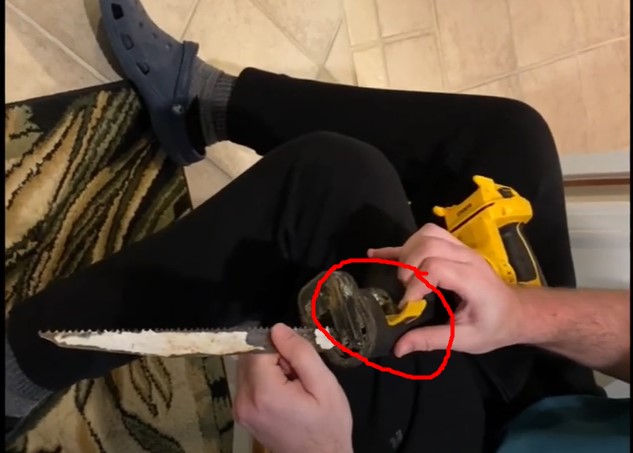
Using Gloves When Handling The Blade
When handling the blade, it’s crucial to prioritize your safety by wearing gloves. Even when the blade has cooled down, it still poses a risk since it has sharp edges and can cause injuries. Gloves protect your hands from direct contact with sharp edges, ensuring that you don’t get cut in the process.
By following these steps, you will be able to remove an old blade from your Dewalt reciprocating saw with ease.
Remember to always prioritize safety when handling sharp tools and equipment to avoid accidents and injuries.
Choosing The New Blade For Dewalt Sawzall
When you’re ready to replace your Dewalt reciprocating saw’s blade, it’s essential to select the right one for your task. Here are the key points to consider:
- Selecting the right type of blade for your task: Start by determining the type of blade you need. If you’re cutting wood, a standard wood blade is the way to go. If metal is your material, you’ll need a metal-cutting blade. In contrast, if you’re working with thick metal, use a carbide-tipped blade, and if you’re cutting through bricks or concrete, a diamond-tipped blade is necessary.
- Understanding blade teeth per inch: The second point to consider is the blade teeth per inch (TPI). A higher TPI produces a smoother cut, while a lower TPI speeds up the cutting process but produces a rougher cut. The general rule is that for thick materials, use a blade with fewer TPI, while for thin materials, go for a higher TPI blade.
- Examining blade quality: Lastly, the quality of your blade matters. Blade quality affects the longevity of the blade, the type of cut you’ll get, and even your safety. When selecting a blade, look for reputable brands, and examine the blade material, sharpness, and coating quality to ensure you’ll have a blade that is durable and safe to use.
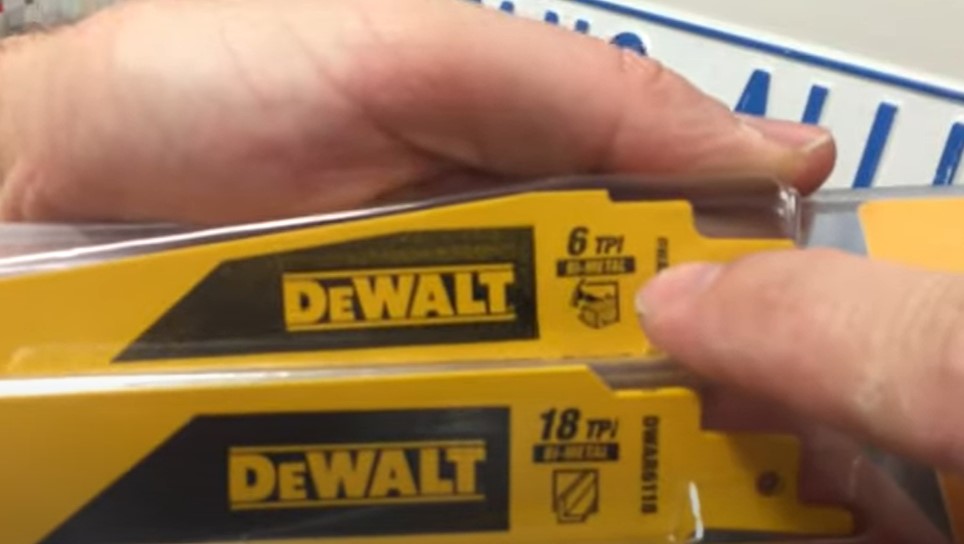
Choosing the right blade for your Dewalt reciprocating saw shouldn’t be complicated. Consider the material you’ll be cutting, the teeth per inch you’ll need, and the blade quality. Remember, using the right blade equals outstanding cutting results.
Inserting A New Blade Into Your Dewalt Reciprocating Saw
Orienting The Blade Correctly
Before inserting the new blade into the Dewalt reciprocating saw, it’s crucial to ensure that the blade is oriented correctly to prevent any accidents or damage to the tool.
Here are some key points to remember:
- Check the blade’s teeth: The teeth of the blade should face downwards when inserted into the saw. Doing this will prevent the tool from jumping or jerking while in use.
- Match the blade to the clamp: Make sure that the blade you’re using is the right one for the clamp. Some blades may have a slightly different shape, which could cause the clamp to slip or fail.
- Check for looseness: Before you insert the blade, ensure that the blade clamp is tight. If the clamp is loose, you may need to tighten it with a wrench or pliers.
Inserting The Blade In The Clamp
Once you have oriented the blade correctly, it’s time to insert it into the clamp of the Dewalt reciprocating saw.
The following are some essential considerations:
- Hold the saw upside down: To insert the blade properly, you will need to hold the tool upside down. This way, you can easily access the blade clamp and insert the blade without any obstructions.
- Push the blade in: Insert the blade into the clamp until it’s seated with the teeth facing downward. Make sure that the blade is centered in the clamp and that it’s not sticking out too far.
- Tighten the clamp: Use a wrench or pliers to tighten the blade clamp until it’s snug. Be careful not to overtighten the clamp, as this could damage the blade or the tool.
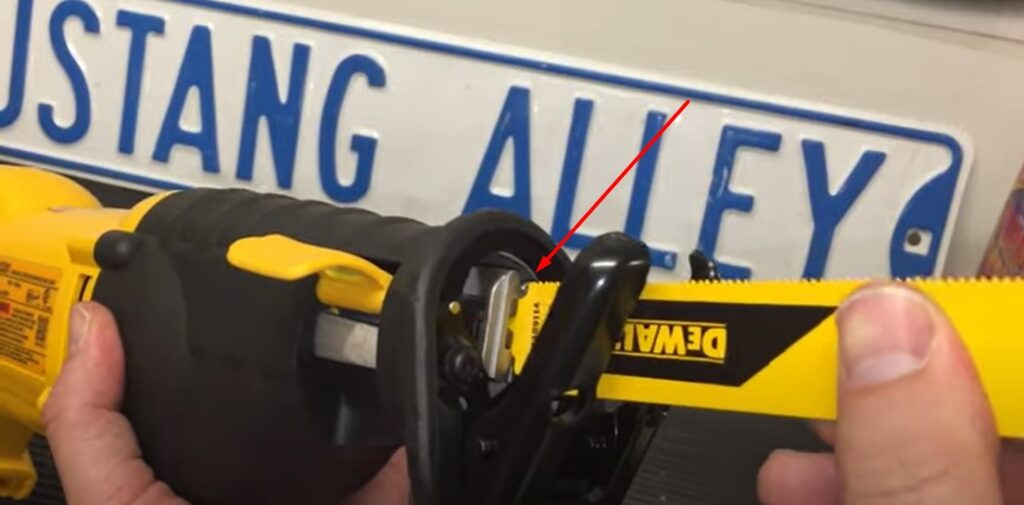
Securing The New Blade
Once you have inserted the new blade into the Dewalt reciprocating saw, the final step is to secure it in place.
Here are some key points to keep in mind:
- Test the blade: Before you start using the saw, test the blade by turning the tool on and off a few times. Check to see if the blade is properly seated and doesn’t wobble or loosen.
- Use the locking mechanism: Some Dewalt reciprocating saws have a locking mechanism to secure the blade in place. If your tool has this feature, use it to ensure that the blade is firmly in place and won’t move during use.
- Check for maintenance: After using the saw, make sure to check the blade for any damage or wear. Replace the blade if it’s dull or damaged to prevent any accidents or damage to the tool.
Testing The New Blade
Putting a blade into a Dewalt reciprocating saw can seem like a daunting task, but once you have got the hang of it, it will be a breeze. However, before you start using the saw, it’s important to test the new blade.
Here’s what you need to assume:
Safety Precautions To Follow While Testing
Before you begin testing the new blade, ensure that you follow these safety precautions to keep yourself and those around you safe.
- Wear protective glasses: Safety glasses are an absolute must whenever you’re working with power tools.
- Wear gloves: Make sure to wear gloves to protect your hands from any sharpness or heat produced by the saw blade.
- Use a sawhorse or clamp: A sawhorse or clamp will keep the material you’re cutting securely in place, reducing the risk of any accidents.
- Ensure power is off: When testing the new blade, ensure that the power is off and the saw is unplugged.
Testing If The Blade Is Tight And Secure
After ensuring that all safety precautions are in place, it’s time to test if your blade is tight and secure.
Here are some tips you can follow:
- Use a hex key: A hex key will come in handy when tightening the set screw that holds the blade in place.
- Give it a wiggle: To ensure that the blade is tight, give it a gentle wiggle. If it’s loose or wobbly, then tighten it further.
- Do not overtighten: While it’s essential to ensure that the blade is secure, do not overtighten, as this may deform the blade. A good rule of thumb is to tighten until you feel resistance, then stop.
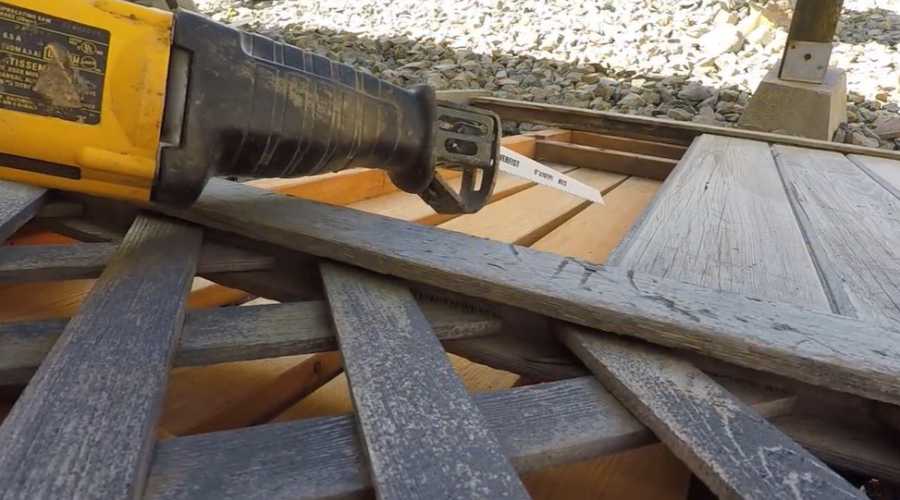
Checking For Blade Alignment And Tension
Lastly, it’s crucial to check for the alignment and tension of the blade. Here’s how you can get this done:
- Check for alignment: The blade should be in line with the saw guide, so check to make sure it’s correctly aligned with the guide.
- Check for tension: Look for the blade’s tension gauge, and ensure that the blade tension is in the green zone. If it isn’t, adjust accordingly.
Testing the new blade is something that you should do before using your Dewalt reciprocating saw. Follow the safety precautions, ensure that the blade is tight and secure and that the alignment and tension of the blade are correct.
Following these steps will set you up for success and make your sawing experience a lot safer and more comfortable.
FAQs: How To Put A Blade Into A Dewalt Reciprocating Saw?
How Do I Put A Blade Into A Dewalt Reciprocating Saw?
Put the blade into the clamp and secure it tight with the set screw.
What Size Blade Do I Need For My Dewalt Reciprocating Saw?
When it comes to choosing the right blade size for your Dewalt reciprocating saw, it’s important to consider the type of material you’ll be cutting and the thickness of the material.
In general, a longer blade will allow you to make deeper cuts, while a shorter blade will give you more control and precision. The most common blade sizes for Dewalt reciprocating saws are 6-inch, 9-inch, and 12-inch blades, but there are also specialized blades available for cutting specific materials like metal, wood, or PVC.
Ultimately, the size of the blade you need will depend on the specific task at hand, so it’s important to choose the right blade for each job.
Can I Use Other Brands Of Blades In My Dewalt Reciprocating Saw?
Yes, as long as the blades are compatible with your Dewalt reciprocating saw.
How Do I Remove A Blade From My Dewalt Reciprocating Saw?
Unplug your saw, press the blade release lever, and gently pull the blade out.
How Do I Maintain My Dewalt Reciprocating Saw Blades?
Clean your blades after each use, store them in a dry place, and replace them when necessary.
What Should I Do If The Saw Blade Gets Stuck In The Wood?
Turn off your saw, unplug it, then use pliers or a blade release lever to remove the blade.
Can I Use My Dewalt Reciprocating Saw To Cut Metal?
Yes, you can use your Dewalt reciprocating saw to cut metal, as long as you use the appropriate blade.
Conclusion
Now that we have learned how to put a blade into a Dewalt reciprocating saw, we can confidently say that this tool is easier to use than it seems. The key to success is to carefully follow the steps we have provided and to make sure that your saw is properly maintained.
Always wear protective gear, such as goggles and gloves, when working with power tools, and keep the workspace clean and organized. By doing so, you will be able to complete your projects efficiently and safely. Remember, practice makes perfect and the more you use your reciprocating saw, the more comfortable you will become.
With the information we have shared in this post, you can now tackle any task that requires a Dewalt reciprocating saw with confidence and ease. Happy sawing!
Recent Posts
Woodworking in 2025 is all about efficiency, precision, and smart technology. Whether you're a beginner or a seasoned craftsman, having the right tools can make all the difference. Here are the top 7...
Ever tried drilling into a piece of wood only to end up with a splintered mess or a wobbly hole? Yeah, it's more common than you think. Wood might seem like an easy material to work with, but...

